Behavior Spectrum-Based Pedestrian Risk Classification via YOLOv8–ByteTrack and CRITIC–Kmeans
Abstract
1. Introduction
- (1)
- It extends Behavior Spectrum Theory to pedestrian crossing by constructing a trajectory–signal behavior spectrum that unifies movement and signal data.
- (2)
- It introduces an improved CRITIC weighting scheme by replacing the mean with the median in the coefficient of variation. The scheme refines feature evaluation by mitigating the influence of outliers and capturing both positive and negative correlations.
- (3)
- It demonstrates a data-driven risk classification framework validated through a large-scale UAV dataset of 1210 crossings and expert evaluation, producing consistent and interpretable results.
2. Related Work
2.1. Behavior Spectrum and Signal-Phase-Based Analyses
2.2. Trajectory Prediction and Algorithmic Approaches
3. Extraction of Spatiotemporal Data in Pedestrian Crossing Scenarios
3.1. Collection of Pedestrian Crossing Video Data
- (1)
- Survey methods capture subjective data such as pedestrians’ intentions, psychological states, crossing decisions, and actions during crossing. However, this approach involves substantial data collection efforts and is time-consuming.
- (2)
- Intersection-mounted cameras can record pedestrian crossing behavior at close range and subsequently compute relevant parameters. Nevertheless, these cameras face challenges such as obstructions by crossing pedestrians, difficulty in computing time-varying parameters, and potential influence on the natural crossing behavior of pedestrians.
- (3)
- Aerial video data offers the advantage of collecting extensive trajectory data of pedestrians in a single session, at a lower cost, with data derived from real-world crossing scenarios.
3.2. Pedestrian Crossing Trajectory–Signal Status Data Acquisition
3.2.1. Pedestrian Crossing Trajectory Data Acquisition
3.2.2. Crossing Light Status Acquisition for Pedestrian Crossing
4. Pedestrian Crossing Behavior Classification Method
4.1. Construction of the Pedestrian Crossing Trajectory–Signal Behavior Spectrum
4.2. Feature Parameter Thresholds and Normalization
4.3. Measurement Methods for the Severity of Pedestrian Crossing Behavior
4.4. Risk Classification by K-Means Clustering Algorithm
5. Experimental Analysis
5.1. Data Source and Experimental Setup for Accuracy Evaluation
5.2. Pedestrian Crossing Feature Parameters
5.2.1. Statistical Distribution of Feature Parameters
5.2.2. Normalization of Pedestrian Crossing Feature Parameters
- (1)
- Calculation of Quartiles: Computing the quartiles of the dataset is a central step in applying the interquartile range method. The quartiles divide the data into four equal parts:
- (2)
- Segmenting the data into multiple intervals based on quartiles helps in clearly defining the relative position of each data value. The definition of each interval is grounded in the distribution features of the data, allowing the scoring to reflect the actual performance of the data. Data values are mapped to predetermined scores according to the interval in which they fall. This mapping technique ensures the objectivity and standardization of the scoring, facilitating comparisons of each data value under the same criteria. For the purposes of this study, data is divided into the following five intervals, with each data value assigned a percentile score:
5.3. Pedestrian Crossing Risk Classification
5.4. Result Validation
5.5. Limitations of Expert Validation
6. Discussion
7. Conclusions
Supplementary Materials
Author Contributions
Funding
Institutional Review Board Statement
Informed Consent Statement
Data Availability Statement
Conflicts of Interest
References
- Bhattarai, K.; Budd, D. Effects of rapid urbanization on the quality of life. In Multidimensional Approach to Quality of Life Issues: A Spatial Analysis; Springer: Singapore, 2019; pp. 327–341. [Google Scholar]
- Schwebel, D.C.; Wu, Y.; Swanson, M.; Cheng, P.; Ning, P.; Cheng, X.; Gao, Y.; Hu, G. Child pedestrian street-crossing behaviors outside a primary school: Developing observational methodologies and data from a case study in Changsha, China. J. Transp. Health 2018, 8, 283–288. [Google Scholar] [CrossRef]
- Ahmed, T.; Moeinaddini, M.; Almoshaogeh, M.; Jamal, A.; Nawaz, I.; Alharbi, F. A new pedestrian crossing level of service (PCLOS) method for promoting safe pedestrian crossing in urban areas. Int. J. Environ. Res. Public Health 2021, 18, 8813. [Google Scholar] [CrossRef] [PubMed]
- Ugan, J.; Abdel-Aty, M.; Cai, Q. Estimating effectiveness of speed reduction measures for pedestrian crossing treatments using an empirically supported speed choice modeling framework. Transp. Res. Part F Traffic Psychol. Behav. 2022, 89, 276–288. [Google Scholar] [CrossRef]
- Amini, R.E.; Katrakazas, C.; Antoniou, C. Negotiation and decision-making for a pedestrian roadway crossing: A literature review. Sustainability 2019, 11, 6713. [Google Scholar] [CrossRef]
- Muslim, H.; Antona-Makoshi, J. A review of vehicle-to-vulnerable road user collisions on limited-access highways to support the development of automated vehicle safety assessments. Safety 2022, 8, 26. [Google Scholar] [CrossRef]
- Arellana, J.; Fernández, S.; Figueroa, M.; Cantillo, V. Analyzing pedestrian behavior when crossing urban roads by combining RP and SP data. Transp. Res. Part F Traffic Psychol. Behav. 2022, 85, 259–275. [Google Scholar] [CrossRef]
- Camara, F.; Bellotto, N.; Cosar, S.; Weber, F.; Nathanael, D.; Althoff, M.; Wu, J.; Ruenz, J.; Dietrich, A.; Markkula, G.; et al. Pedestrian models for autonomous driving part ii: High-level models of human behavior. IEEE Trans. Intell. Transp. Syst. 2020, 22, 5453–5472. [Google Scholar] [CrossRef]
- Wu, C.; Cai, Z.; He, Y.; Lu, X. A review of vehicle group intelligence in a connected environment. IEEE Trans. Intell. Veh. 2023, 9, 1865–1889. [Google Scholar] [CrossRef]
- Fehlmann, G.; O’RIain, M.J.; Fürtbauer, I.; King, A.J. Behavioral causes, ecological consequences, and management challenges associated with wildlife foraging in human-modified landscapes. BioScience 2021, 71, 40–54. [Google Scholar] [CrossRef]
- Houpt, K.A. Domestic Animal Behavior for Veterinarians and Animal Scientists; John Wiley & Sons: Hoboken, NJ, USA, 2024. [Google Scholar]
- Ridel, D.; Rehder, E.; Lauer, M.; Stiller, C.; Wolf, D. A literature review on the prediction of pedestrian behavior in urban scenarios. In Proceedings of the 21st International Conference on Intelligent Transportation Systems (ITSC), Maui, HI, USA, 4–7 November 2018. [Google Scholar]
- Azadani, M.N.; Boukerche, A. Driving behavior analysis guidelines for intelligent transportation systems. IEEE Trans. Intell. Transp. Syst. 2021, 23, 6027–6045. [Google Scholar] [CrossRef]
- Sanguino, T.J.M.; Domínguez, J.M.L.; González, M.J.R.; Martin, J.M.D. New Approach to Intelligent Pedestrian Detection and Signaling on Crosswalks. IEEE Trans. Intell. Transp. Syst. 2024, 25, 21416–21428. [Google Scholar] [CrossRef]
- Stock, E.V.; Silva, R. Exploring crossing times and congestion patterns at scramble intersections in pedestrian dynamics models: A statistical analysis. Phys. A Stat. Mech. Its Appl. 2024, 649, 129942. [Google Scholar] [CrossRef]
- Sighencea, B.I.; Stanciu, I.R.; Căleanu, C.D. D-stgcn: Dynamic pedestrian trajectory prediction using spatio-temporal graph convolutional networks. Electronics 2023, 12, 611. [Google Scholar] [CrossRef]
- Alghodhaifi, H.; Lakshmanan, S. Holistic Spatio-Temporal graph attention for trajectory prediction in Vehicle–Pedestrian interactions. Sensors 2023, 23, 7361. [Google Scholar] [CrossRef]
- Czech, P.; Braun, M.; Kreßel, U.; Yang, B. Behavior-aware pedestrian trajectory prediction in ego-centric camera views with spatio-temporal ego-motion estimation. Mach. Learn. Knowl. Extr. 2023, 5, 957–978. [Google Scholar] [CrossRef]
- Silva, R.M.; Azevedo, G.F.; Berto, M.V.; Rocha, J.R.; Fidelis, E.C.; Nogueira, M.V.; Lisboa, P.H.; Almeida, T.A. Vulnerable Road User Detection and Safety Enhancement: A Comprehensive Survey. arXiv 2024, arXiv:2405.19202. [Google Scholar] [CrossRef]
- Klein, J.; Leupold, S.; Biegler, I.; Biedendieck, R.; Münch, R.; Jahn, D. TLM-Tracker: Software for cell segmentation, tracking and lineage analysis in time-lapse microscopy movies. Bioinformatics 2012, 28, 2276–2277. [Google Scholar] [CrossRef] [PubMed]
- Wu, W.; Zhang, B.; Hu, L.; Zhang, Z. Dynamic prediction model of pedestrian crossing orientation probability based on human-vehicle interaction. J. Mech. Eng. 2024, 60, 40–50. [Google Scholar]
- Chandra, R.; Guan, T.; Panuganti, S.; Mittal, T.; Bhattacharya, U.; Bera, A.; Manocha, D. Forecasting trajectory and behavior of road-agents using spectral clustering in graph-lstms. IEEE Robot. Autom. Lett. 2020, 5, 4882–4890. [Google Scholar] [CrossRef]
- Wang, J.; Xu, W.; Fu, T.; Gong, H.; Shangguan, Q.; Sobhani, A. Modeling aggressive driving behavior based on graph construction. Transp. Res. Part C Emerg. Technol. 2022, 138, 103654. [Google Scholar]
- Dąbkowski, P.; Olszewski, P.; Czajewski, W. Pedestrian Danger Index—A novel surrogate measure of pedestrian safety at unsignalized crossings. Traffic Inj. Prev. 2024, 26, 11–12. [Google Scholar] [CrossRef] [PubMed]
- Almodfer, R.; Xiong, S.; Fang, Z.; Kong, X.; Zheng, S. Quantitative analysis of lane-based pedestrian-vehicle conflict at a non-signalized marked crosswalk. Transp. Res. Part F Psychol. Behav. 2016, 42, 468–478. [Google Scholar] [CrossRef]
- Chen, W.; Wang, T.; Wang, Y.; Li, Q.; Xu, Y.; Niu, Y. Lane-based distance-velocity model for evaluating pedestrian-vehicle interaction at non-signalized locations. Accid. Anal. Prev. 2022, 176, 106810. [Google Scholar] [CrossRef] [PubMed]
- Fu, T.; Miranda-Moreno, L.; Saunier, N. A novel framework to evaluate pedestrian safety at non-signalized locations. Accid. Anal. Prev. 2018, 111, 23–33. [Google Scholar] [CrossRef]
- Safaldin, M.; Zaghden, N.; Mejdoub, M. An improved YOLOv8 to detect moving objects. IEEE Access 2024, 12, 59782–59806. [Google Scholar] [CrossRef]
- Kim, S.-W.; Kook, H.-K.; Sun, J.-Y.; Kang, M.-C.; Ko, S.-J. Parallel feature pyramid network for object detection. In Proceedings of the European Conference on Computer Vision (ECCV), Munich, Germany, 8–14 September 2018. [Google Scholar]
- Laurikkala, J.; Juhola, M.; Kentala, E.; Lavrac, N.; Miksch, S.; Kavsek, B.; Laurikkala, J. Informal identification of outliers in medical data. In Proceedings of the Fifth International Workshop on Intelligent Data Analysis in Medicine and Pharmacology, Berlin, Germany, 22 August 2000; Volume 1, pp. 20–24. [Google Scholar]
- Wang, Y.; Jiang, X.; Zhang, L. Research on the evaluation of science and technological awards based on improved CRITIC method and cloud model. J. Hunan Univ. Nat. Sci. 2014, 41, 118–124. [Google Scholar]
- Ye, F.; Sun, J.; Wang, Y.; Nedjah, N.; Bu, W. A novel method for the performance evaluation of institutionalized collaborative innovation using an improved G1-CRITIC comprehensive evaluation model. J. Innov. Knowl. 2023, 8, 100289. [Google Scholar] [CrossRef]
- Wang, Z.; Zhong, Y.; Chai, S.-L.; Niu, S.-F.; Yang, M.-L.; Wu, G.-R. Product design evaluation based on improved CRITIC and Comprehensive Cloud-TOPSIS–Applied to automotive styling design evaluation. Adv. Eng. Inform. 2024, 60, 102361. [Google Scholar] [CrossRef]
- Szandała, T. ChatGPT vs. human expertise in the context of IT recruitment. Expert Syst. Appl. 2025, 264, 125868. [Google Scholar] [CrossRef]
- Bonhomme, V.; Castets, M.; Morel, J.; Gaucherel, C. Introducing the vectorial Kappa: An index to quantify congruence between vectorial mosaics. Ecol. Indic. 2015, 57, 96–99. [Google Scholar] [CrossRef]
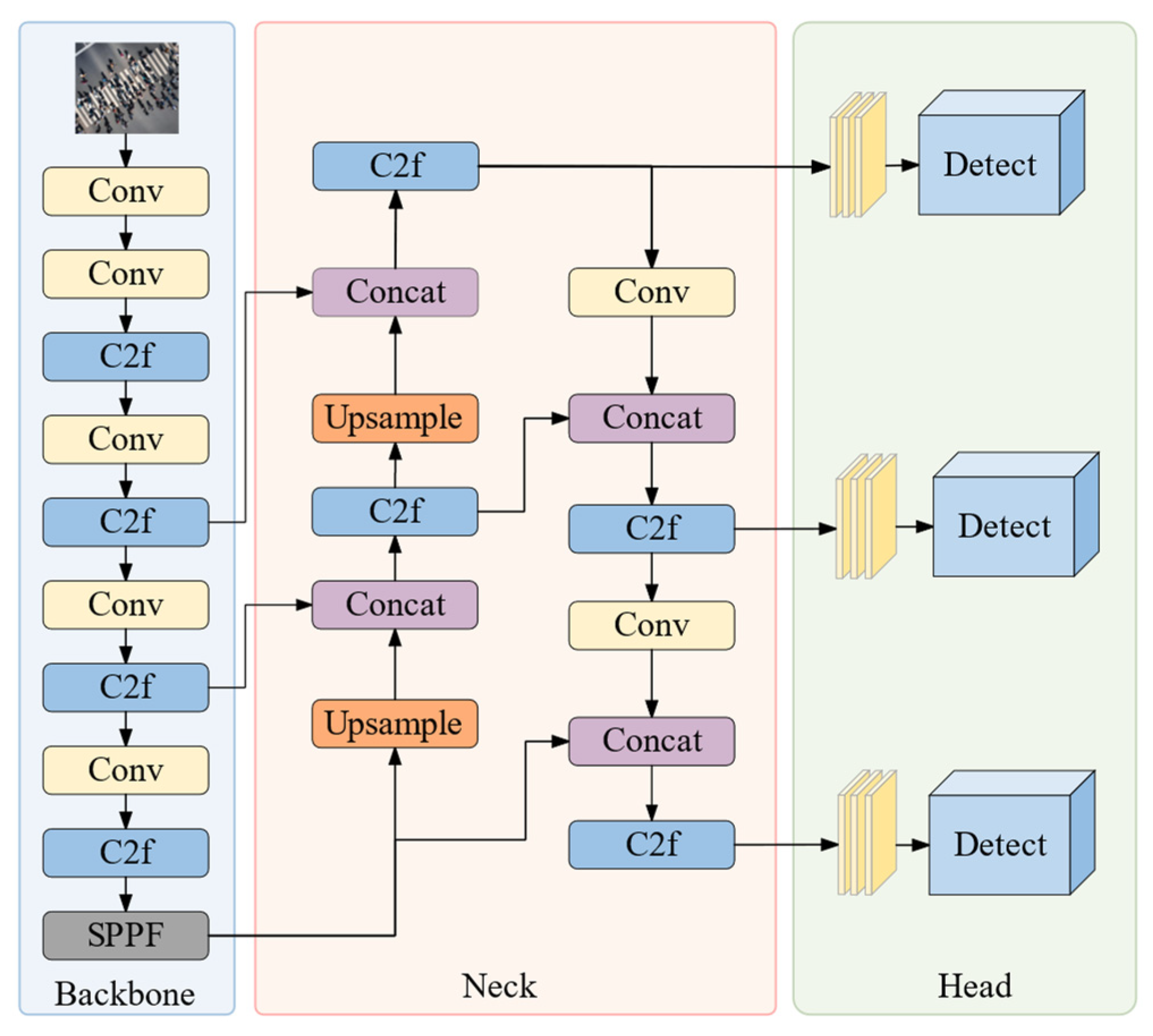
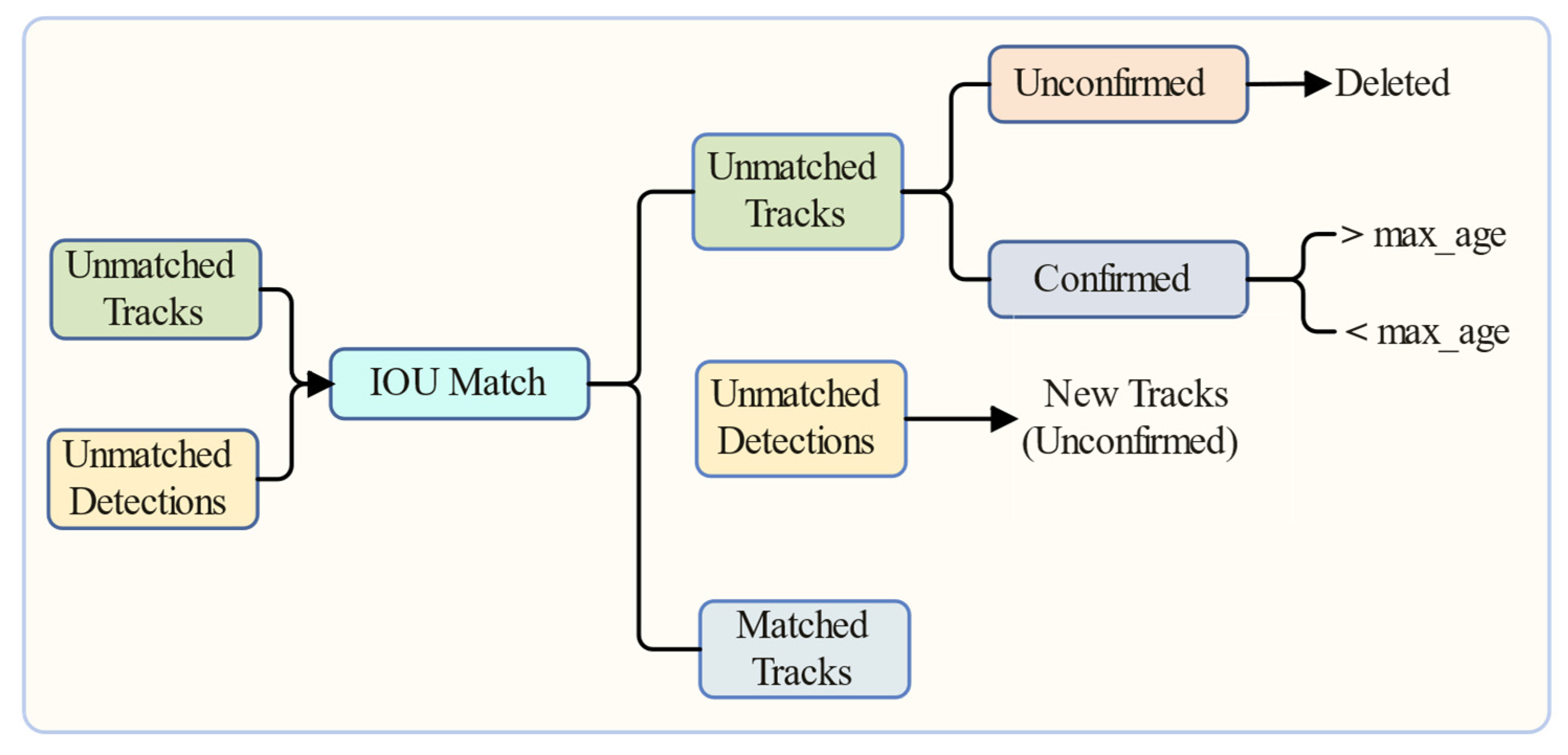
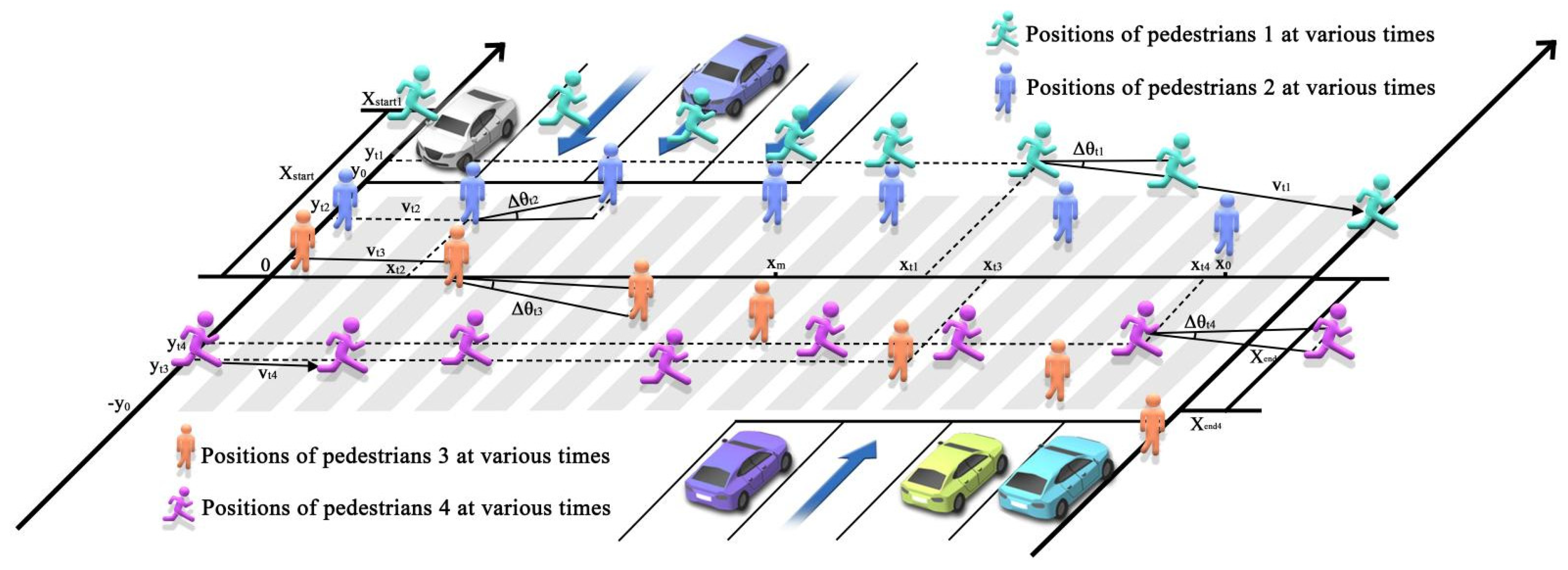
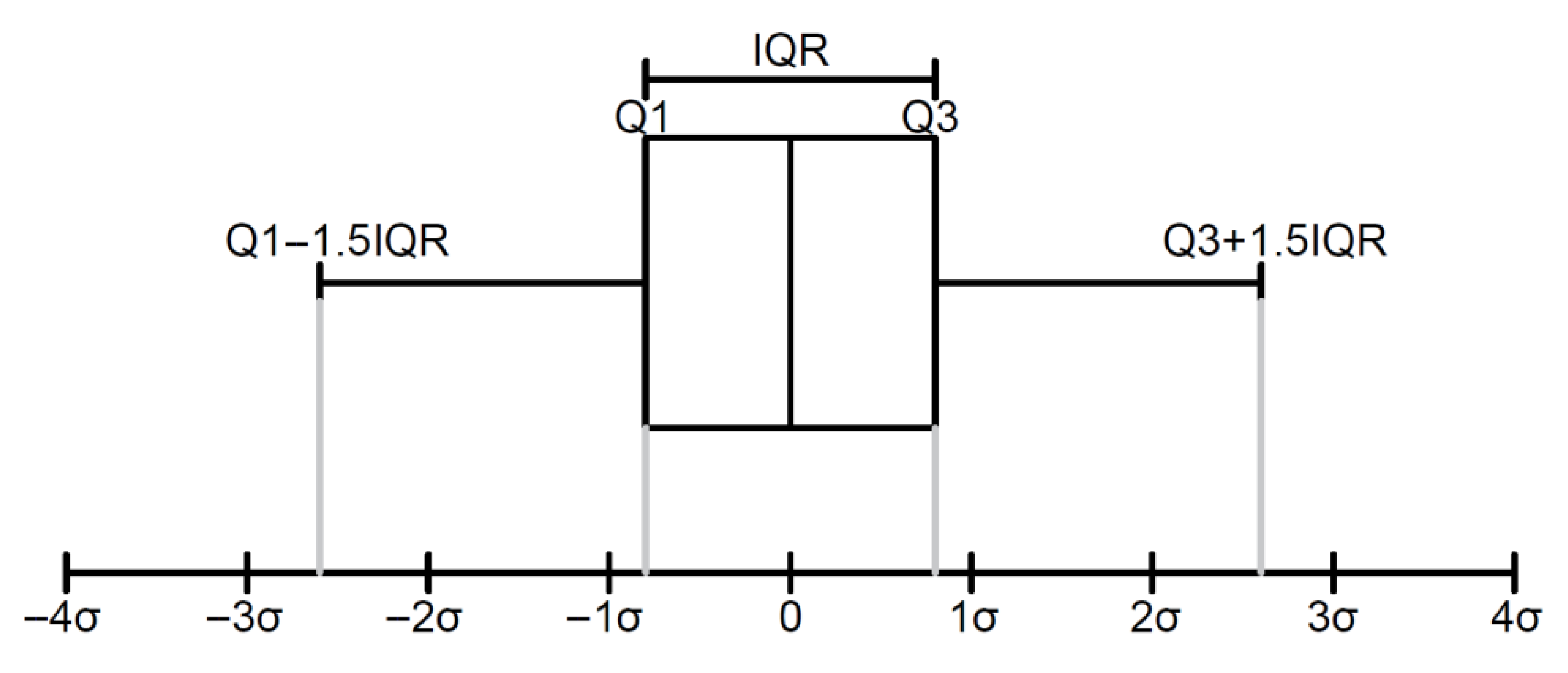
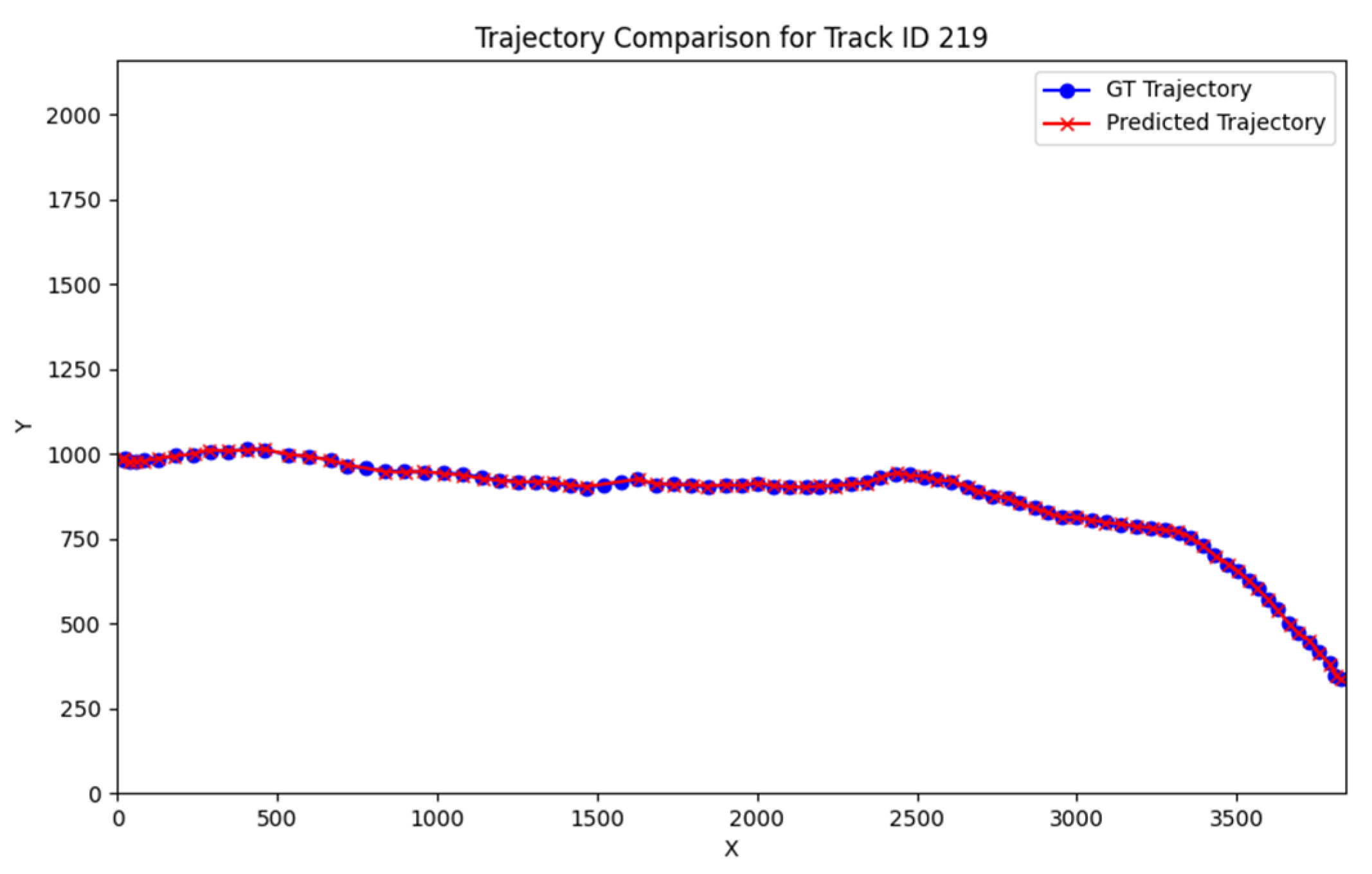

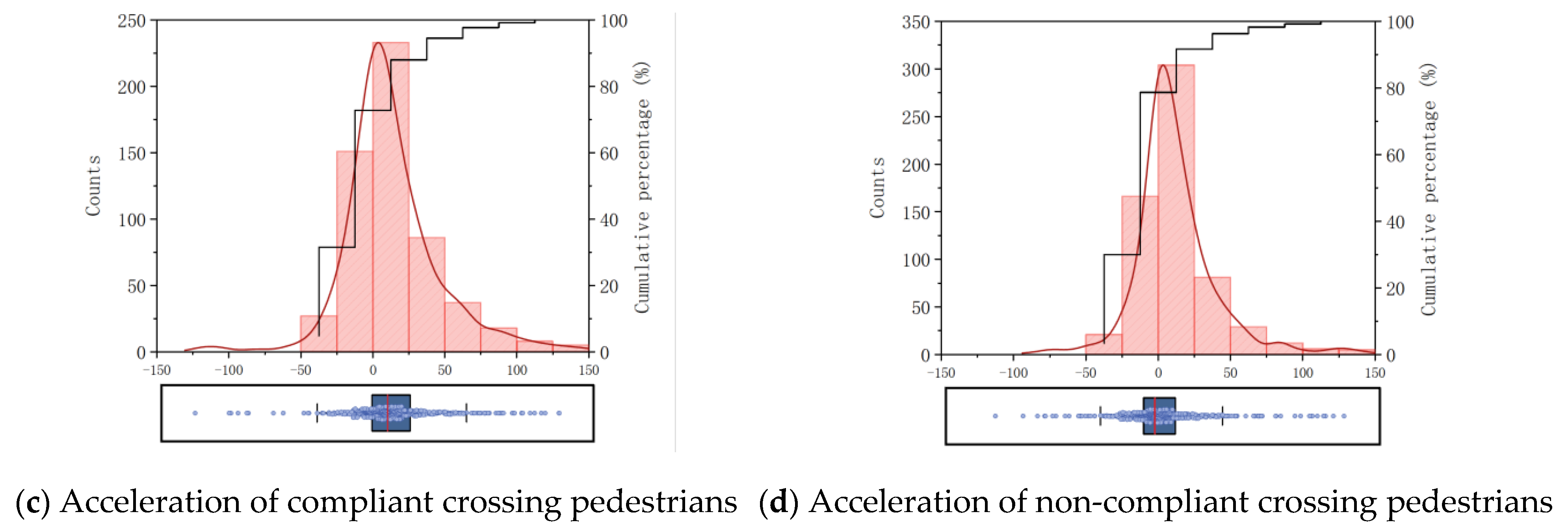
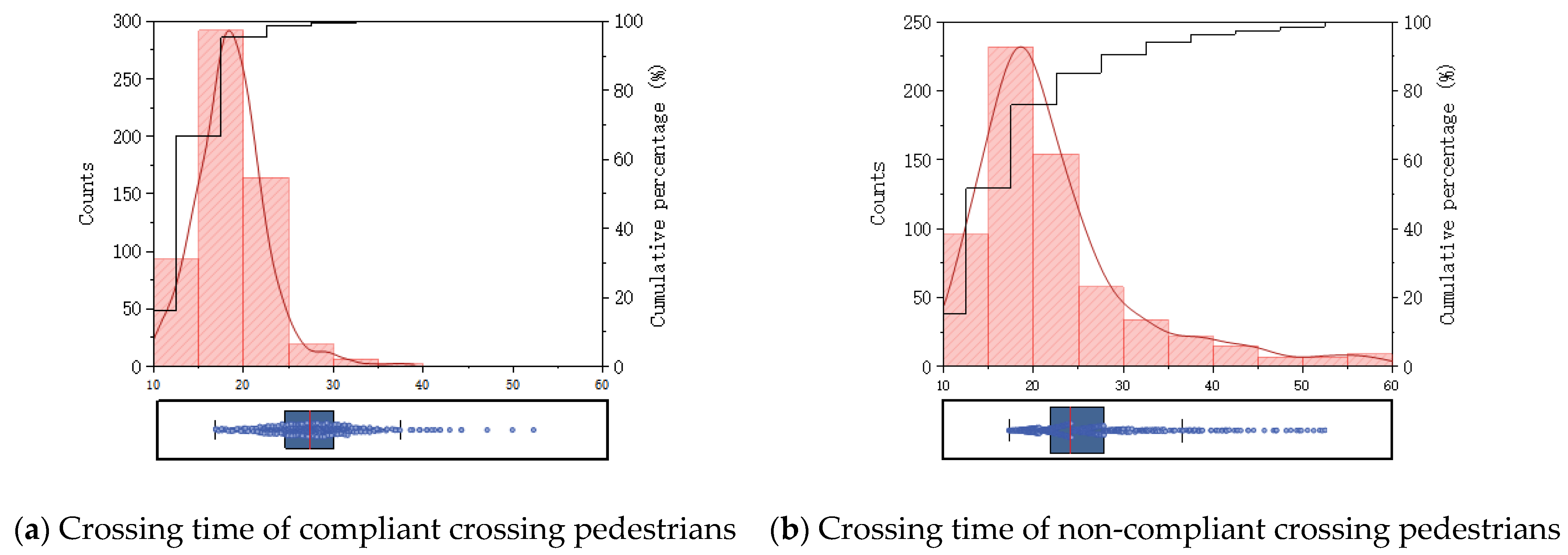
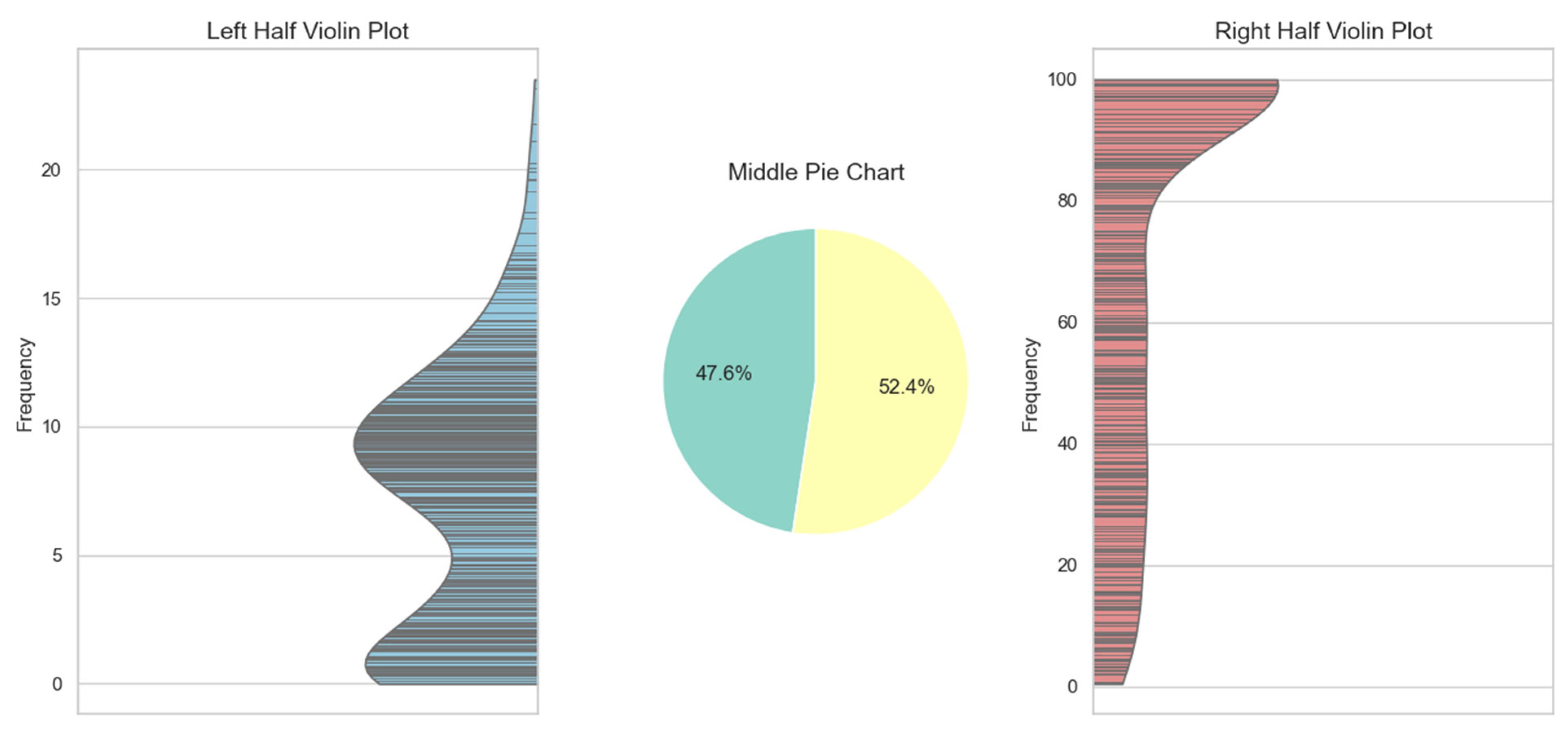
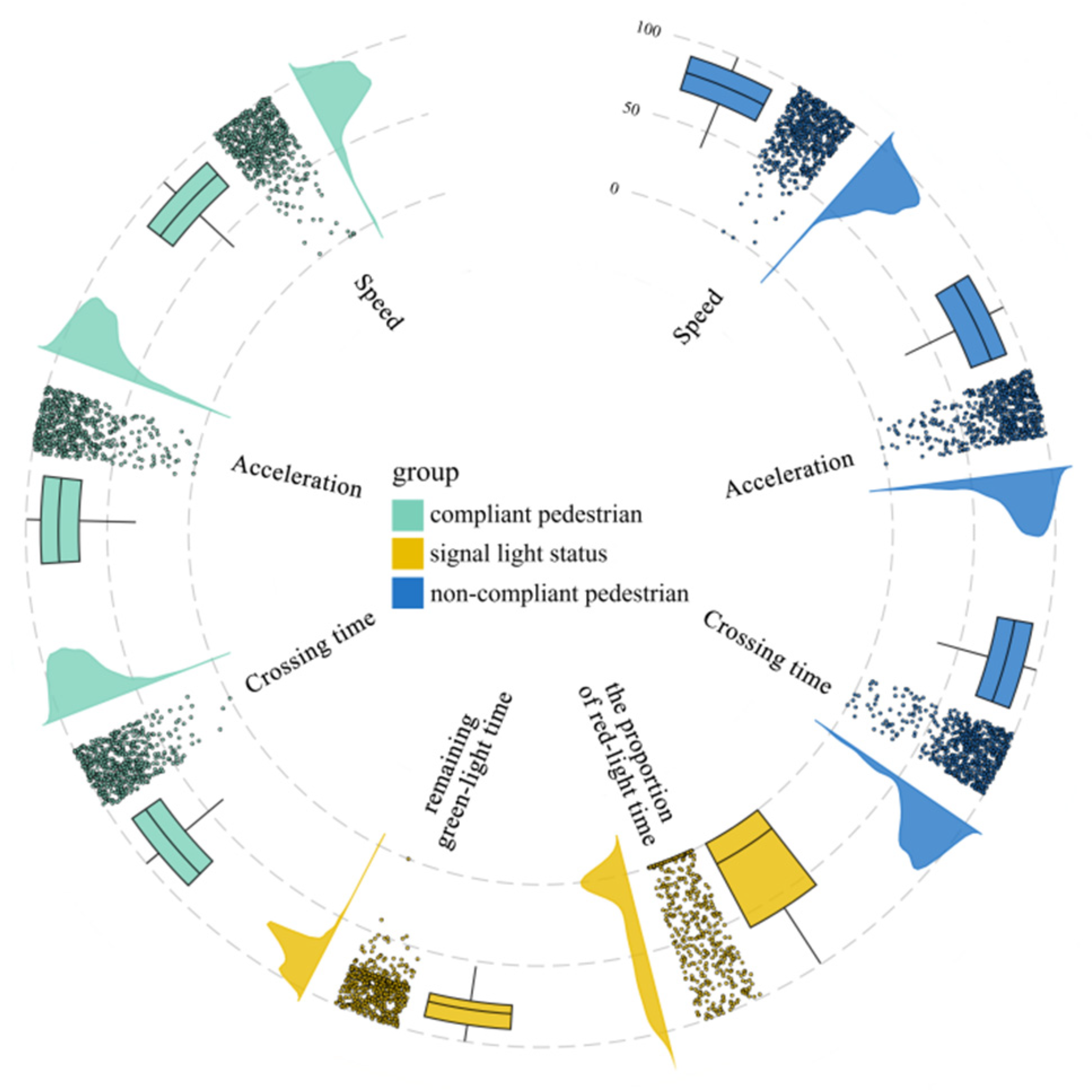
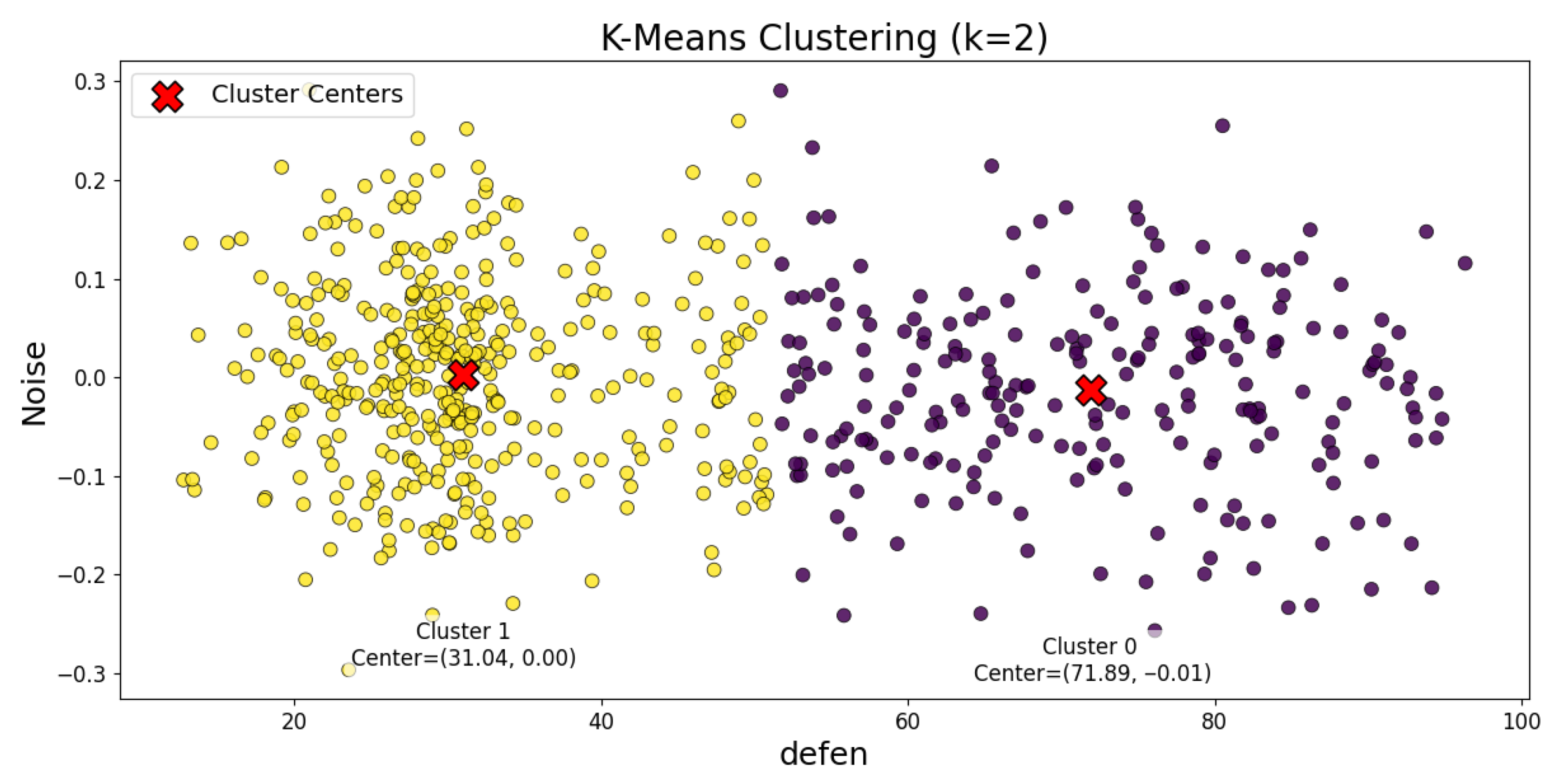
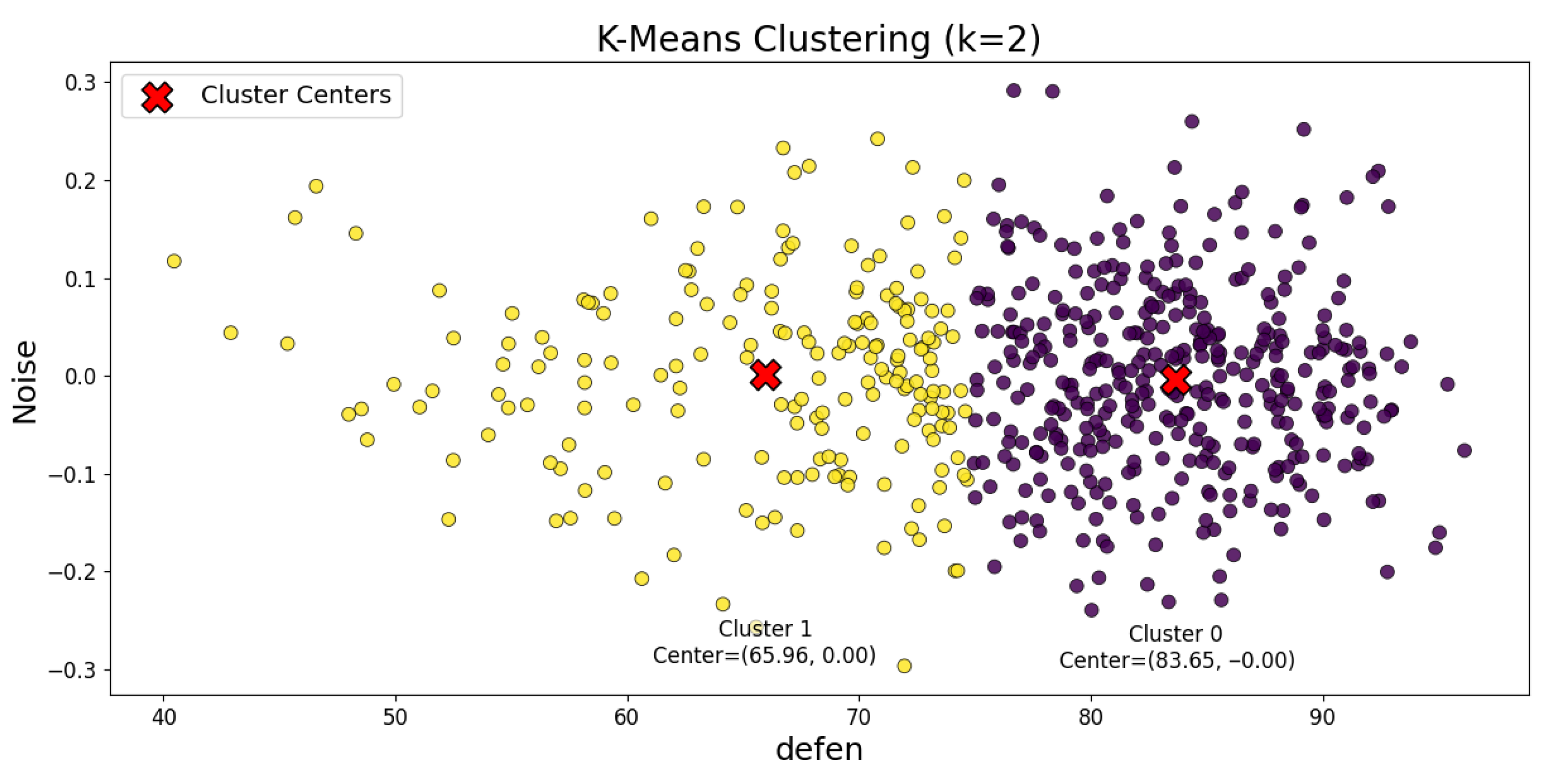
| ID | Speed | Acceleration | Crossing Time | Remaining Green-Light Time | Red-Light Duration |
|---|---|---|---|---|---|
| 1 | v1 | a1 | t1 | tgreen1 | 0 |
| 2 | v2 | a2 | t2 | 0 | tred1 |
| 3 | v3 | a3 | t3 | 0 | tred1 |
| n | vn | an | tn | tgreenn | 0 |
| Scenario Parameters | Information |
|---|---|
| Presence of signal control | Yes |
| Number of lanes | Eight lanes (bi-directional) |
| Pedestrian crosswalk length | 30 m |
| Pedestrian crosswalk width | 8 m |
| Weather | Sunny |
| Signal-phase ratio | Red:green = 3:1 |
| Pedestrian ID | Pedestrian Type | Speed m/s | Acceleration m/s2 | Crossing Time s | Remaining Green-Light Time s | Red-Light Duration s |
|---|---|---|---|---|---|---|
| 1 | Compliant crossing | 1.19 | 0.47 | 22.63 | 2.38 | 0 |
| 2 | 1.40 | −0.14 | 18.08 | 11.67 | 0 | |
| 3 | 1.33 | −0.84 | 21.00 | 4.67 | 0 | |
| 4 | Non-compliant crossing | 0.78 | 0.02 | 35.79 | 0 | 28.21 |
| 5 | 1.94 | 0.55 | 14.42 | 0 | 14.42 |
| Pedestrian groups | Compliant crossing pedestrians | Non-compliant pedestrians | ||
| Eigenvalue types | Compliant eigenvalue | Non-compliant eigenvalue | ||
| Clustering centers | 83.65 | 65.96 | 71.89 | 31.04 |
| Eigenvalues | (75, 100) | (0, 75) | (51, 100) | (0, 51) |
| Risk levels | No risk | Low risk | Medium risk | High risk |
| Pedestrian number | 1 | 2 | 3 | 4 | 5 | 6 | 7 | 8 | 9 | 10 | 11 | 12 | 13 | 14 | 15 | 16 | 17 | 18 | 19 | 20 |
| Classification result | N | N | N | N | N | L | L | L | L | L | M | M | M | M | M | H | H | H | H | H |
| Expert 1 | N | N | N | N | N | L | L | L | L | L | M | M | M | L | M | H | H | H | H | H |
| Expert 2 | N | N | N | N | N | N | L | L | L | L | M | H | M | M | M | H | H | H | H | H |
| Expert 3 | N | N | N | N | N | L | L | L | L | L | M | M | M | M | M | H | H | H | H | H |
Disclaimer/Publisher’s Note: The statements, opinions and data contained in all publications are solely those of the individual author(s) and contributor(s) and not of MDPI and/or the editor(s). MDPI and/or the editor(s) disclaim responsibility for any injury to people or property resulting from any ideas, methods, instructions or products referred to in the content. |
© 2025 by the authors. Licensee MDPI, Basel, Switzerland. This article is an open access article distributed under the terms and conditions of the Creative Commons Attribution (CC BY) license (https://creativecommons.org/licenses/by/4.0/).
Share and Cite
Sun, J.; Pei, Y. Behavior Spectrum-Based Pedestrian Risk Classification via YOLOv8–ByteTrack and CRITIC–Kmeans. Appl. Sci. 2025, 15, 10008. https://doi.org/10.3390/app151810008
Sun J, Pei Y. Behavior Spectrum-Based Pedestrian Risk Classification via YOLOv8–ByteTrack and CRITIC–Kmeans. Applied Sciences. 2025; 15(18):10008. https://doi.org/10.3390/app151810008
Chicago/Turabian StyleSun, Jianqi, and Yulong Pei. 2025. "Behavior Spectrum-Based Pedestrian Risk Classification via YOLOv8–ByteTrack and CRITIC–Kmeans" Applied Sciences 15, no. 18: 10008. https://doi.org/10.3390/app151810008
APA StyleSun, J., & Pei, Y. (2025). Behavior Spectrum-Based Pedestrian Risk Classification via YOLOv8–ByteTrack and CRITIC–Kmeans. Applied Sciences, 15(18), 10008. https://doi.org/10.3390/app151810008






